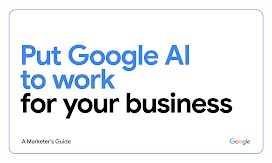
As the leaders of Google’s Ads and Cloud marketing teams — and as marketers ourselves — we talk to many partners and friends about AI in marketing. One of the things we hear most clearly is that people want to move beyond the hype to the how.
So, to help marketers get their heads around the opportunities and how to make the most of what AI enables, we’ve developed a framework for how to put AI to work in your marketing.
This article lays out essential actions you can take to get started and how to scale when you’re ready.
Investing in your first-party data strategy can give you a solid AI foundation and drive quick wins, growth, and efficiency for your business. Google’s AI-powered campaign products and off-the-shelf products and tools can help you achieve these benefits.
For those who want to do more, Google Cloud offers a powerful platform for broader AI transformation. That can include purpose-built solutions, like a custom creative studio or AI-powered predictive audiences and analytics, to give you a competitive edge.
Whether you’re just getting started or looking to maximize what AI can do, our AI framework is a great resource to help you think about how to take advantage of using AI in your marketing, and to assess what you’re already doing vis-à-vis what’s possible.
The AI for Marketing Engine
Until recently, marketing practices followed a fairly linear path. We’d create content intended for a specific audience; publish it on the channels or platforms where our audiences were; measure its effect on marketing metrics (often only rough proxies for business growth); tweak it; then repeat the process.
Enter AI and a framework we call the “AI for Marketing Engine.” It’s premised on familiar marketing functions: creative, media, and measurement. These aren’t independent activities, of course. They’re increasingly interlinked, but they’re a useful way to categorize the opportunities AI offers.
Let’s take a closer look at each.

Measurement and insights
You might ask, “Why start with measurement and insights? Don’t they usually come last?”
We start here because to successfully adapt AI in marketing requires setting a solid foundation for your data and measurement. First-party data is the fuel that AI uses to uncover unique insights and trends, identify valuable audiences, and help you better measure customer lifetime value.
AI can transform measurement’s role in your marketing, helping you go from analyzing historical trends to acting on predictive insights.
Your organization is likely already rich with this kind of marketing data: surveys, customer reviews, transaction, and loyalty-program data. It will be crucial to combine this information and to identify any gaps.
But even the best data sets are only as valuable as the action you take on them. AI can transform measurement’s role in your marketing, helping you go from analyzing historical trends to acting on predictive insights and enabling outcome-based marketing.
For instance, metrics like predictive lifetime value are incredibly beneficial for planning and testing. They can help you predict repeat shoppers or those likely to refer friends, so you can focus on those customers to increase brand and sales lift.
PepsiCo is a powerful example of a company that’s put AI to work in this way. Many of its brands don’t typically have direct relationships with consumers, so they’ve used innovative ways to build first-party relationships. Placing QR codes on packaging and in stores to connect customers with their rewards programs has helped deepen audience insights and shift shopper relationships from purely transactional to something more long term and more profitable.
Questions to ask your team

Media and personalization
The longtime dream for marketers has been the “right ad, right person, right place, right time.” Today that dream is closer to reality than ever before, because AI is the ultimate real-time optimization engine.
For years, predictive AI has helped us understand the intent behind millions of queries every second, evaluate tens of millions of potential ads, and then choose the best one. It’s what powers the bidding and audience solutions that match people to ads.
But showing the perfect ad on every surface has been a real challenge. Now, generative AI is poised to unlock enormous new opportunities and a whole new era of ad experiences. Our latest Gemini models are supporting an entire ecosystem of products, platforms, and APIs, including tools such as Demand Gen and Performance Max. These AI-powered campaigns enable you to optimize for business results like sales, revenue, or profitability.
Generative AI is poised to unlock enormous new opportunities and a new era of ad experiences.
A good first step toward putting AI to work here is to implement a test, learn, and scale approach. Start by testing your AI-powered campaigns against your manual ones. Scale quickly once you see impact. Once you scale, use your data, combined with AI, to segment your customers based on propensity models and your specific needs. No matter where you are in this process, make sure to continuously optimize against your business objectives.
International fitness brand Les Mills is a case study in this approach. When people couldn’t go to gyms during the pandemic, it doubled down on offering the best fitness video content in the world. The company used Demand Gen to create a compelling visual storytelling experience to find and convert new subscribers. Over a four-week test, it drove 561% more sign-ups at a 72% more efficient cost per trial. Now Les Mills uses Demand Gen campaigns across all of its markets.
Footwear and clothing company Vans has also benefited from AI-powered campaigns. Like many apparel brands, it faced the challenge of managing the fluctuating demands and unpredictability of the holiday season. While a difficult task to navigate manually, this challenge is exactly what AI is good at.
Vans used Performance Max to create personalized customer journeys for its diverse audience. This meant delivering the right message, at the right time, to the right person — whether they were die-hard skateboarders or parents gearing up for back-to-school. The results were impressive: Vans achieved a 46% increase in conversions and an 86% sales lift, compared to its prior shopping solutions.
Questions to ask your team

Creative and content
Today’s campaigns are increasingly complex. They often require thousands of assets running simultaneously across devices, platforms, and audiences. It’s simply not possible for teams to keep up with the volume, velocity, and variations of assets necessary to drive meaningful performance — while meeting a high bar of quality.
To speed up the development and relevance of your creative, you can use AI to format, trim, and resize your existing assets for different channels. It can add captions, dub your videos, and even learn from your creative library to generate entirely new ads.
AI solutions also make it possible for you to test, refine, and optimize all of your assets at scale. AI can analyze copy, images, and video alongside performance data to help you understand what makes your top-performing creative work. It allows you to shift your marketing and visuals based on time, culture, and opportunities. This makes new creative workflows possible, and unlocks new ways to develop creative in-house and with agencies.
To improve campaign quality and reduce time to market, French retailer and wholesaler Carrefour and its marketing team built an AI creative studio with Google Cloud, and trained it on the company’s brand guidelines and most successful campaigns. Now, the AI learns from Carrefour’s historical campaign data and, when fed guidelines for an upcoming program, it can create a first draft of comprehensive marketing campaigns in a matter of minutes.
Questions to ask your creative teams and agencies

Implement AI across your business
As you invest in AI, there are three key areas to consider to ensure successful adoption across your organization: relationships, results, and responsibility.
Relationships: Identify your Magic Circle
It’s critical to create and develop relationships and advocacy across your organization, such as with your finance, engineering, legal, HR, and product teams. We think of this as the “Magic Circle’’ we need around us to deliver on the promise of AI for marketing. It takes a great deal of cross-functional support to move from marketing pilots to full-scale integrated programs.

There’s no one-size-fits-all organizational design, but here are some key questions to consider:
- Who is in your Magic Circle already? Identify these stakeholders before you need them, while you are building out your first solutions.
- Who else might you need to bring in? Identify the relationships you need to build. Taking action can be as simple as setting up a coffee next month.
- Work with your peers to complete the business cases for your desired initiatives. What needs to happen, and why is it important from an overall business perspective?
Results: Measure your progress with AI
You’ll want to ensure that you have a strong business case for continuing to invest in AI across your organization. Depending on the project, you may choose to measure the success of your AI initiatives based on revenue growth or cost savings. Revenue growth can come from projects, such as creating more effective creative with AI or being able to respond to trends or customer requests faster than ever before. Cost savings can come from reducing time spent on AI-eligible tasks, such as resizing or formatting creative, translating, or personalizing content for thousands of people. Whichever is the right metric for your project, ensure that you set goals and track progress.
Responsibility: Provide guardrails for AI implementation
Finally, based on our conversations with marketing leaders, it’s clear that the industry is committed to principled AI adoption. It’s important to remember that the market is flooded with AI models and providers accessible to anyone in your organization. Partner with reputable organizations who can explain how they will protect your data and IP. Give your team access to trustworthy AI tools, so they don’t make suboptimal choices that put your organization or data at risk.
We look forward to continuing the conversation about how marketing leaders can put AI to work. In time, we believe the marketing process will turn into an all-at-once efficiency and growth flywheel — fast creative production, tailored media activation, and real-time measurement, all working together to drive performance. This future sounds pretty awesome, and we’re excited to help build it, together.




